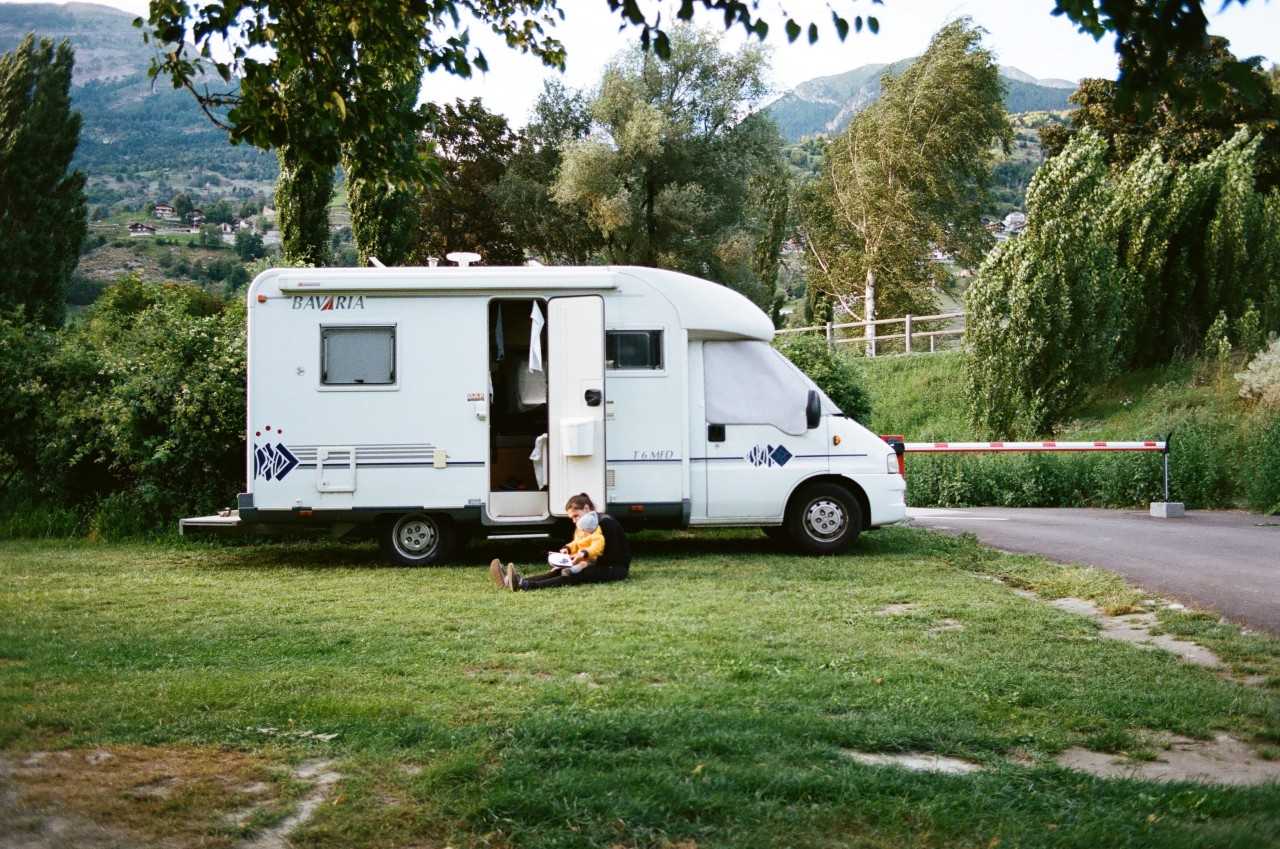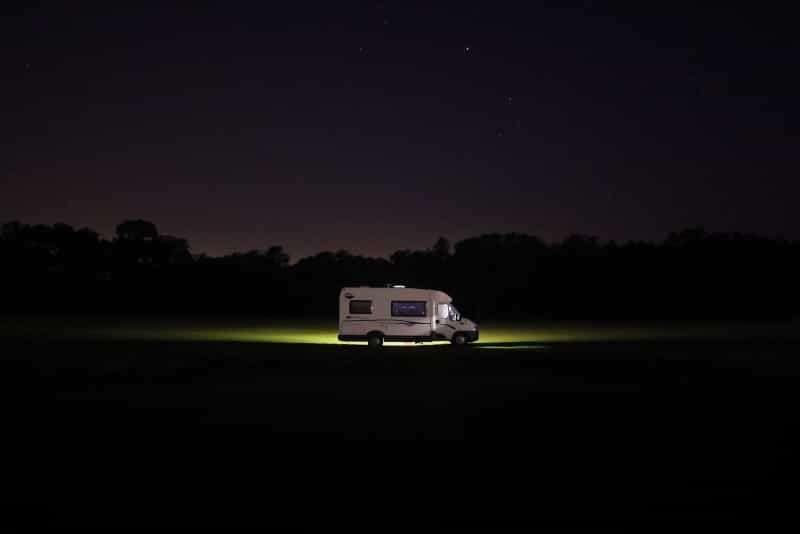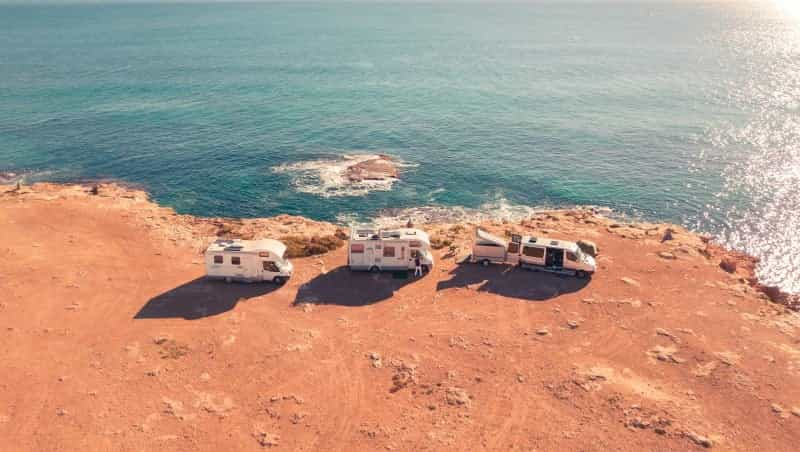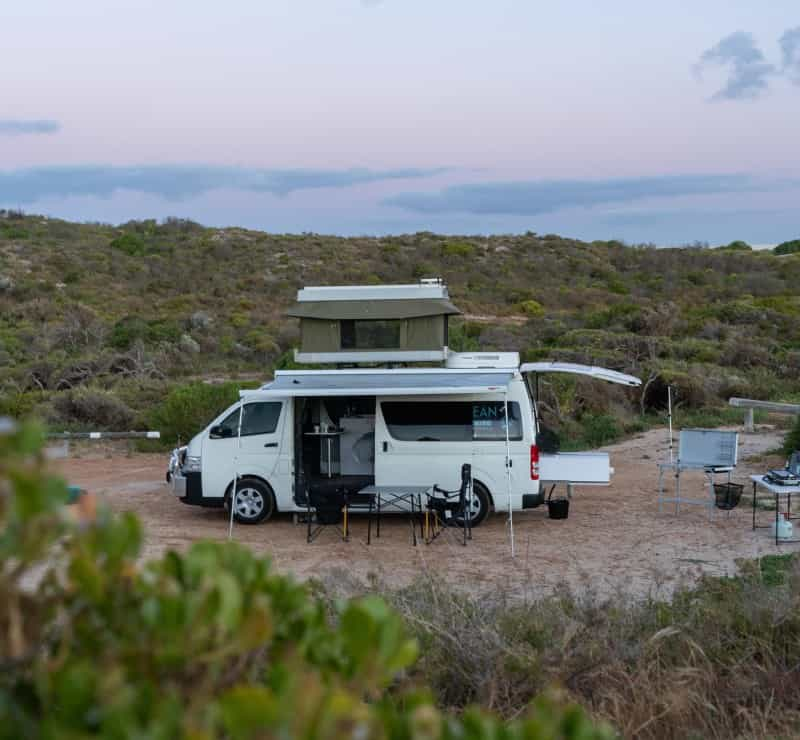Beginners’ guide to motorhome holidays
It’s hard to beat a motorhome holiday for a feeling of freedom. Not only do you get your own kitchen and bathroom facilities on board, you can also change destination whenever you feel like it.
It can be daunting to head off on a motorhome holiday for the first time, though – which is where our expert advice comes in. If you’ve just hired or bought a live-in vehicle, our guide will help you with everything from keeping the toilet clean to finding the best campsites.

Motorhome holiday tips for beginners
Here’s some handy advice to consider ahead of your first trip.
-
Hire a motorhome before you decide to invest in one, so you can figure out whether the lifestyle is for you. It’ll also give you an insight into what type of vehicle and contents would suit you the most.
-
Ask for a handover from whoever you’re buying a motorhome from, whether that's a dealership or the previous owner, so you can learn the intricacies of that particular van.
-
Practise getting to grips with driving your motorhome locally before setting off on a big trip.
-
Stay overnight on your driveway ahead of your first holiday to make sure you know how everything works, from the blinds to the pull-out bed.
-
Follow a motorhome packing checklist to ensure you don’t leave anything important behind. But don’t overpack – you need to keep the weight of your vehicle in mind.
-
Switch the fridge on for a few hours before you leave home as it can take a long time to cool down to the right temperature.
-
Check you have all the keys for the external lockers, especially the locking water filler cap.
-
Invest in a GPS that allows you to enter the type of vehicle you’re driving and its physical dimensions. This can stop you from being directed under low bridges and narrow roads.
- Have all your motorhome papers at hand, such as insurance, emergency contact details and Green Card (a green piece of paper showing registration details).
How to use your motorhome
As well as getting the insurance you need and practising how to drive a motorhome, it’s important to learn how the gas, electricity and toilet work. You'll need to maintain these on a regular basis to keep your vehicle in good working condition.
Gas
Your motorhome will have a gas system to fuel your hob and heating. To get to grips with this, first you need to find out whether it uses replaceable bottles or has an in-built LPG tank.
If it uses gas bottles, keep these tips in mind:
-
Your cylinder(s) should be located in the appropriate locker, standing upright and secured using the attached straps.
-
A dark-orange bottle usually means your gas system is fuelled by propane, while blue means it’s fuelled by butane. Most motorhome users prefer propane as it stays stable in lower temperatures, so it’s best in colder climates or when taking motorhome holidays all year round.
-
Butane is more efficient, so some owners will swap out their propane bottle in warmer months.
-
You can buy replacement gas bottles at petrol stations, camping supply shops and motorhome dealers. Some campsites will also stock them. It's worth calling ahead to see if they have the size and type you need, though, as this varies.
-
It can be tricky to locate certain types of gas in different countries. For example, Calor is the most common type in the UK but you can’t generally find it across Europe.
-
Some motorhome owners like to keep a spare gas bottle on board to have a replacement on hand. This way, you won’t have to drive far out of the way trying to refill yours if it runs out.
-
Make sure there’s a carbon monoxide alarm fitted inside your vehicle. This will warn you if there’s a build-up of CO from gas in your motorhome, which can be deadly.
-
When you run out of fuel, you'll need a gas spanner to swap the cylinder over, so make sure you pack one of these.
If it has an LPG tank:
Many newer motorhomes have a refillable LPG supply installed, and this is a cheaper and easier system than exchanging your propane or butane gas cylinder.
Here’s how to refill most motorhome LPG gas tanks.
1. Turn your engine off and make sure the tap on the bottle is closed.
2. Remove the black refill cap by twisting it in an anti-clockwise direction.
3. Put the pump nozzle into the gas flow point and turn it.
4. Squeeze the nozzle handle and lock in an open position.
5. Push and hold the flow button on the LPG pump.
6. The pump will automatically stop when it’s full.
7. Release the filler nozzle – usually it’ll make a loud hissing noise.
8. Replace the filler cap.
Travelling around Europe? You’ll need to use your LPG bottle’s adaptors. Locate the right one and screw it tightly onto the filler nozzle.
The toilet
The more regularly you use your on-board toilet, the more frequently you'll need to clean the cassette. This is why many motorhome users try to use public and campsite toilets where possible (which also reduces the risk of unpleasant smells).
How to empty your motorhome toilet:
1. Remove your toilet cassette from the motorhome.
2. Wheel or carry it to the chemical disposal point at your campsite or aire.
3. Twist the nozzle, unscrew a cap and press the air-pressure release button to drain out the waste.
4. Rinse the cassette with fresh water, at least twice.
5. Add portable toilet chemicals to disinfect the container and minimise smells.
6. Pop the clean cassette back into place in the motorhome.
7. Make sure it’s locked in place properly.
Electricity

Your 12V leisure battery
-
Motorhomes use a 12V DC leisure battery to power up devices and appliances in your living space. You need to keep energy use to a minimum when not driving around regularly or are not hooked up to external electricity at a campsite or aire, otherwise it will go flat.
-
For more freedom to go without mains hook-ups for longer, buy a second-hand leisure battery as a backup. Not all campsites have electric pitches and you might decide to wild camp in your motorhome from time to time.
-
Make sure you know where your 12V fuse box is and what type of fuses it needs. Bring spares just in case yours blow.
-
When you need to recharge your battery, you can start the engine and idle your motorhome for a while to build up the power. This will drain your petrol or diesel, though.
Power-saving tips for your 12V battery
-
Turn the water pump off when you’re not using it so that it doesn’t auto-cycle during the night.
-
Have short showers. Rinse first, then turn off the water as you lather yourself with soap. Turn it back on for a final rinse.
-
Use a water bottle to pour into the toilet for the rinse cycle instead of using the toilet pump.
How to use your electric hook-up
-
When you’ve paid for an electric pitch at a campsite, plug the mains hook-up cable into your motorhome’s socket then connect the other end into the electric hook-up stand.
-
If the electricity isn't working, you might need to check the hook-up bollard’s consumer unit hasn’t tripped. Reset it if it has (or ask the site owner for help). Alternatively, it might be that your motorhome's own electricity unit has tripped.
-
Motorhomes have nowhere near the electrical capacity of a real home, whether you're using the leisure battery or hook-up at your pitch. The risk of tripping your power means you'll want to invest in low-power appliances for your living quarters.
Where can you stay in a motorhome?
There are three main options:
Campsites
The best place to park your motorhome is at an official campsite. Not all can cater for large self-contained vehicles, however, so browse motorhome pitches to find ones that do.
You might also want to look for parks with motorhome service points, so you can deal with the chemical waste from your on-board bathroom. Many motorhome users prefer sites with showers and toilets to limit having to use their own.
If you’re on a longer trip, campsites with laundry facilities are lifesavers.
Aires
Many countries have a low-cost network of stopovers for motorhomes. These are usually basic parking areas, although some will have access to electricity hook-ups and toilets. You can often fill up on fresh water and drain your waste and toilet tanks at aires. Some are free, while others charge a nominal fee for an overnight stay.
Wild camping

The beauty of owning a motorhome is that it can give you the freedom to camp in the wild. There are certain laws you need to follow, though – it’s largely not legal to sleep overnight anywhere you like. Click on the link below to find out all the details.
Go wild camping in a motorhome
What to look for in a pitch
Ground type: In warmer weather you can get away with parking on grass pitches, particularly if the ground is dry and hard. Your best bet is to choose a hardstanding, however, as motorhomes can easily become stuck in waterlogged grass.
Size: Memorise or write down your vehicle's width and length. Most motorhome pitches will fit your unit, but it's worth double-checking, either on the online campsite listing or by asking the owner. You'll want room for a little extra space to sit outdoors and extend your awning too, if possible. All the motorhome campsites in our selection have info on pitch size, so it’s easy to find the right one for your vehicle.
Electricity access: As you'll be relying on your leisure battery when off-grid in your motorhome, it's worth paying extra for an electric pitch when staying at a campsite. This means you can charge up all your devices and use more appliances simultaneously. Plugging into a mains hook-up will also activate a mains charger to top up your leisure battery.
Water on tap: Choose a fully serviced pitch for easy access to water as well as electricity. It's worth buying two different sizes (21mm and 26mm outer diameter) of threaded plastic water tap fittings to connect your water hose to an external tap.
After getting to your pitch
Here are the errands you may want to complete as soon as you arrive at your campsite:
-
Park up within easy reach of the pitch’s electric hook-up and water tap.
-
Put your handbrake on and use levelling blocks under the motorhome’s wheels if needed.
-
Lower the stabilising jacks.
-
Connect to the electricity hook-up.
-
Get out your water hose and fill up your water tank from the tap.
-
Empty your waste water tank and toilet.
-
Turn on the air-conditioning or heating if needed.
-
Switch on your gas supply.
-
Raise your TV antenna/satellite dish if necessary.
-
Set up your awnings if you have them.
-
Put your outdoor furniture out.

Before leaving your pitch
These are some of the tasks to take care of before driving away from your campsite, whether permanently or for the day:
-
Unplug the mains hook-up lead.
-
Turn off the gas bottle or LPG gas tank.
-
Put paper towels between crockery to stop rattling noises.
-
Make sure to retract the external footstep outside your door.
-
Secure everything properly, including closing cupboards and drawers, to avoid breakages while driving.
-
Shut rooflights, windows and doors and clip your electric hook-up cover in place.
How to secure your pitch while out for the day
Some campsites will give you a designated place to park, meaning you can return to exactly the same space after your day out in the van. Others have a pick-your-own-pitch setup, so you might lose your spot if you drive off on an adventure. Some people leave an inexpensive object – perhaps a stake, sign, waste container or camping chair – to mark that the space is occupied.
One of the benefits of using campsites rather than free-parking your motorhome? It reduces your risk of being broken into, especially if the site has strong security like an entrance barrier and plenty of staff around.
You'll still want to follow these basic security tips, however.
-
Get into the habit of locking your motorhome when you're away from it – even just for five minutes.
-
Switch your burglar alarm on if you have one.
-
Keep any expensive items out of view.
-
Close curtains and blinds so thieves don’t know whether anyone is inside.
-
Put outdoor equipment like paddleboards and bikes inside the motorhome.
-
Get locks for your steering wheel, clutch, gearstick and/or pedals, along with a wheel clamp.
-
Invest in a door deadlock, window catches and window security film, as well as an interior motion sensor alarm.
Top tip: It's worth being extra vigilant at motorhome aires as thieves are known to target these places.
Motorhome holiday FAQs
What do I need to know about using a motorhome for the first time?
As well as learning how to drive a motorhome, it’s worth understanding how the on-board gas system, electricity, heating and toilet work. You’ll also need to know how to maintain these components properly to keep your vehicle safe and in good working order.
Where can you camp in a motorhome?
You can stay at campsites and motorhome stopovers (aires) or try wild camping. If you opt for the latter, you’ll need to check the laws in the country you’re travelling through. Generally speaking, you can’t park up overnight on private land unless you ask for permission from the owner.
Do you need an electric hook-up for motorhomes?
It’s not absolutely vital, but having access to mains electricity – instead of relying on your motorhome’s leisure battery – can make your holiday more enjoyable and comfortable.